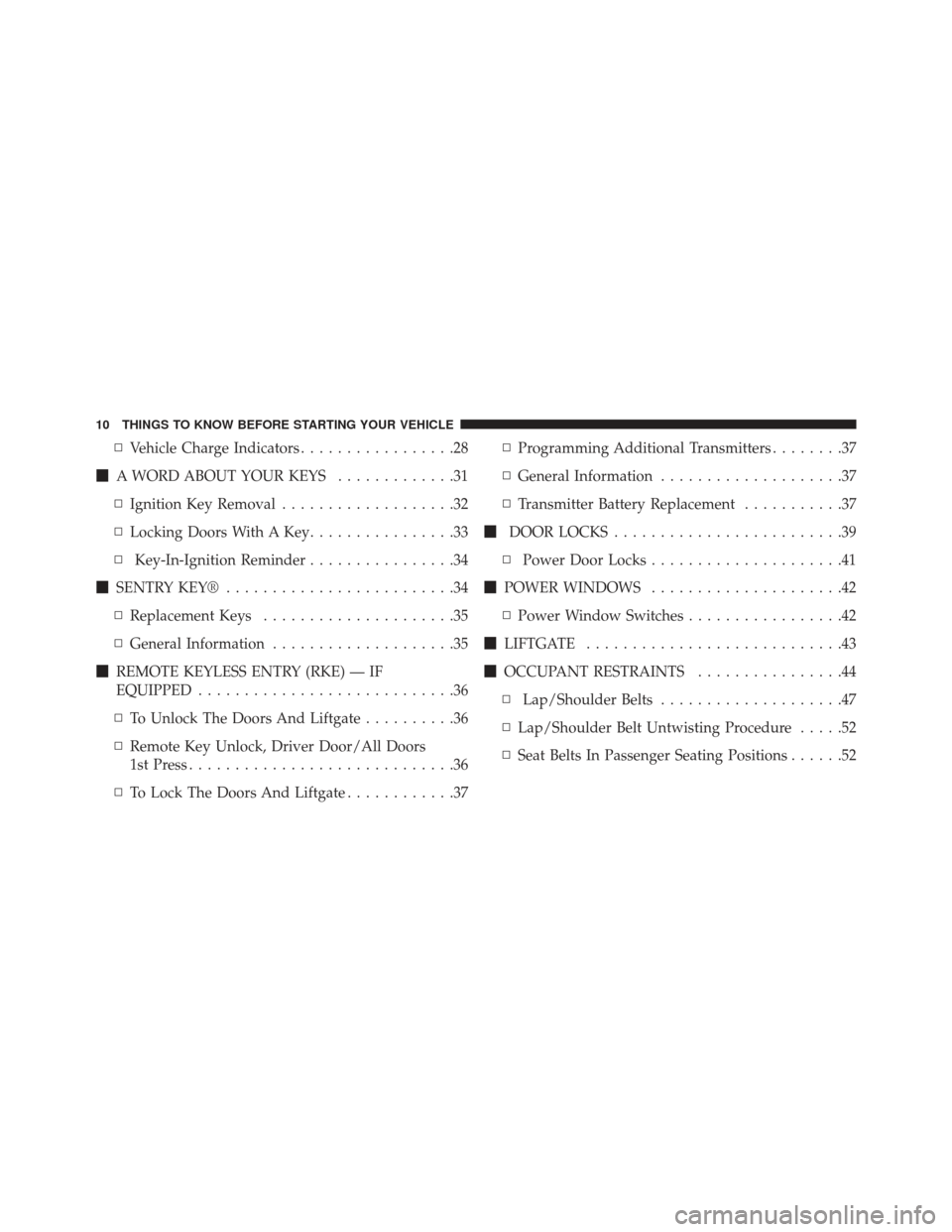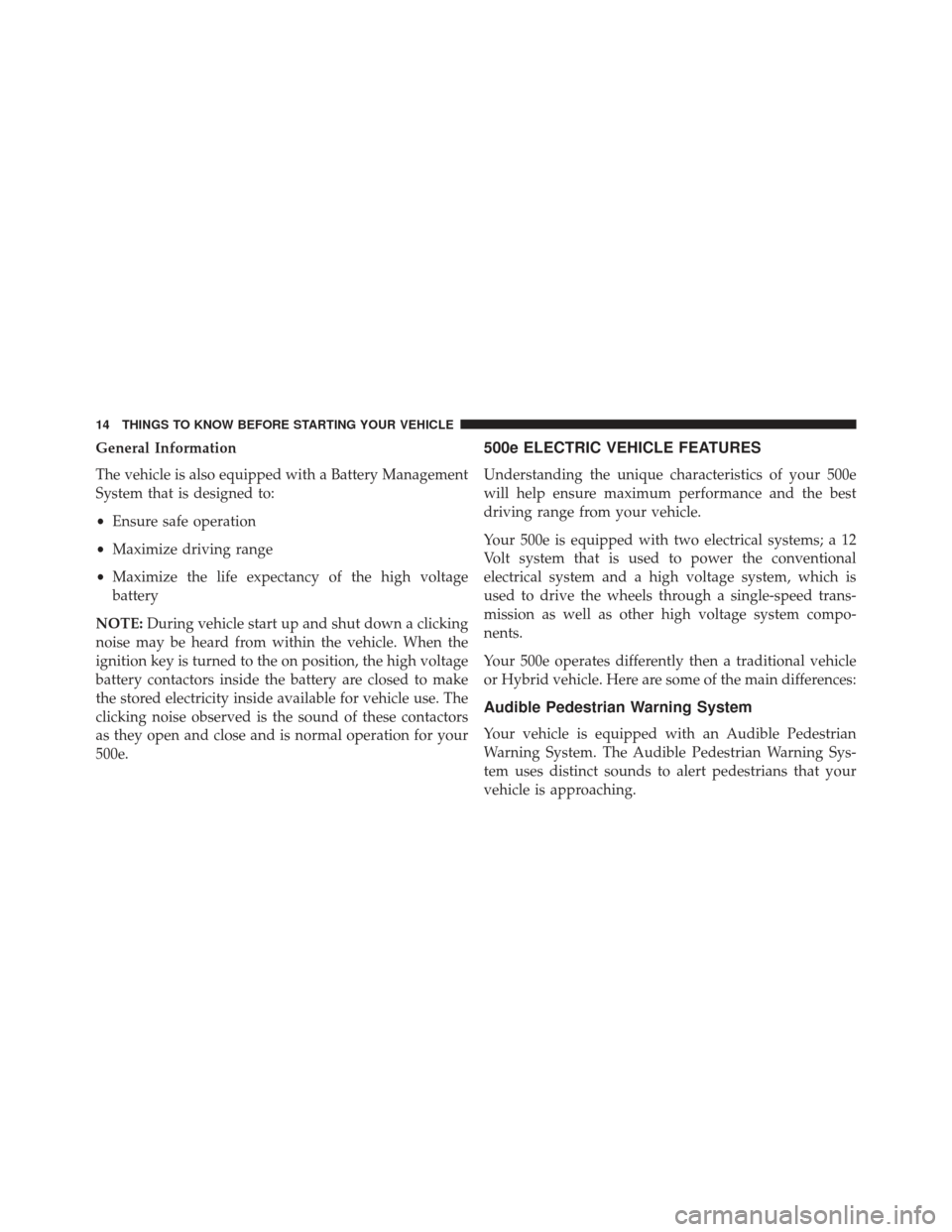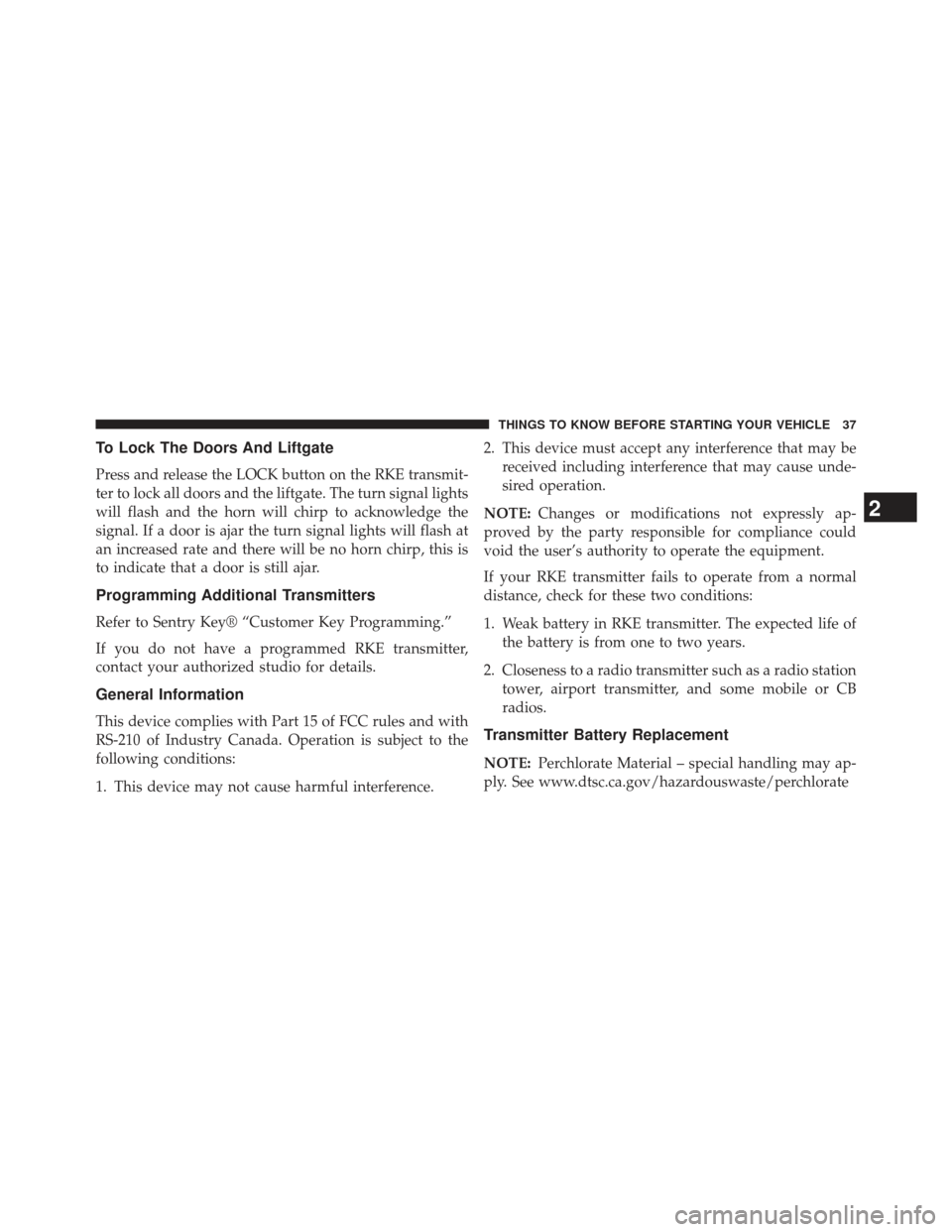Page 12 of 350

▫Vehicle Charge Indicators .................28
� A WORD ABOUT YOUR KEYS .............31
▫ Ignition Key Removal ...................32
▫ Locking Doors With A Key ................33
▫ Key-In-Ignition Reminder ................34
� SENTRY KEY® .........................34
▫ Replacement Keys .....................35
▫ General Information ....................35
� REMOTE KEYLESS ENTRY (RKE) — IF
EQUIPPED ............................36
▫ To Unlock The Doors And Liftgate ..........36
▫ Remote Key Unlock, Driver Door/All Doors
1stPress.............................36
▫ To Lock The Doors And Liftgate ............37▫
Programming Additional Transmitters ........37
▫ General Information ....................37
▫ Transmitter Battery Replacement ...........37
� DOOR LOCKS .........................39
▫ Power Door Locks .....................41
� POWER WINDOWS .....................42
▫ Power Window Switches .................42
� LIFTGATE ............................43
� OCCUPANT RESTRAINTS ................44
▫ Lap/Shoulder Belts ....................47
▫ Lap/Shoulder Belt Untwisting Procedure .....52
▫ Seat Belts In Passenger Seating Positions ......52
10 THINGS TO KNOW BEFORE STARTING YOUR VEHICLE
Page 16 of 350

General Information
The vehicle is also equipped with a Battery Management
System that is designed to:
•Ensure safe operation
• Maximize driving range
• Maximize the life expectancy of the high voltage
battery
NOTE: During vehicle start up and shut down a clicking
noise may be heard from within the vehicle. When the
ignition key is turned to the on position, the high voltage
battery contactors inside the battery are closed to make
the stored electricity inside available for vehicle use. The
clicking noise observed is the sound of these contactors
as they open and close and is normal operation for your
500e.500e ELECTRIC VEHICLE FEATURES
Understanding the unique characteristics of your 500e
will help ensure maximum performance and the best
driving range from your vehicle.
Your 500e is equipped with two electrical systems; a 12
Volt system that is used to power the conventional
electrical system and a high voltage system, which is
used to drive the wheels through a single-speed trans-
mission as well as other high voltage system compo-
nents.
Your 500e operates differently then a traditional vehicle
or Hybrid vehicle. Here are some of the main differences:
Audible Pedestrian Warning System
Your vehicle is equipped with an Audible Pedestrian
Warning System. The Audible Pedestrian Warning Sys-
tem uses distinct sounds to alert pedestrians that your
vehicle is approaching.
14 THINGS TO KNOW BEFORE STARTING YOUR VEHICLE
Page 33 of 350
NOTE:In the event of an error in the charging process
the outer two lights will blink.
Number Of Indicator Lights Illuminated Percent Of Battery
Charge
1 Light 0 – 20%
2 Lights 21 – 40%
3 Lights 41 – 60%
4 Lights 61 – 80%
5 Lights 81 – 100%
A WORD ABOUT YOUR KEYS
The key fob contains the Remote Keyless Entry (RKE)
transmitter with an integrated key. To use the mechanical
key simply press the mechanical key release button. The vehicle is supplied with a code card containing key
code numbers to order duplicate keys, and the autho-
rized studio that sold you your new vehicle has the key
code numbers for your vehicle locks. These numbers can
be used to order duplicate keys.
Mechanical Key Release Button
2
THINGS TO KNOW BEFORE STARTING YOUR VEHICLE 31
Page 39 of 350

To Lock The Doors And Liftgate
Press and release the LOCK button on the RKE transmit-
ter to lock all doors and the liftgate. The turn signal lights
will flash and the horn will chirp to acknowledge the
signal. If a door is ajar the turn signal lights will flash at
an increased rate and there will be no horn chirp, this is
to indicate that a door is still ajar.
Programming Additional Transmitters
Refer to Sentry Key® “Customer Key Programming.”
If you do not have a programmed RKE transmitter,
contact your authorized studio for details.
General Information
This device complies with Part 15 of FCC rules and with
RS-210 of Industry Canada. Operation is subject to the
following conditions:
1. This device may not cause harmful interference.2. This device must accept any interference that may be
received including interference that may cause unde-
sired operation.
NOTE: Changes or modifications not expressly ap-
proved by the party responsible for compliance could
void the user’s authority to operate the equipment.
If your RKE transmitter fails to operate from a normal
distance, check for these two conditions:
1. Weak battery in RKE transmitter. The expected life of the battery is from one to two years.
2. Closeness to a radio transmitter such as a radio station tower, airport transmitter, and some mobile or CB
radios.Transmitter Battery Replacement
NOTE: Perchlorate Material – special handling may ap-
ply. See www.dtsc.ca.gov/hazardouswaste/perchlorate
2
THINGS TO KNOW BEFORE STARTING YOUR VEHICLE 37
Page 40 of 350
The recommended replacement battery is CR2032.
1. Press the mechanical key release button and releasethe mechanical key to access the battery case screw
located on the side of the Key Fob. 2. Rotate the screw located on the side of the Key Fob
using a small screwdriver.
Mechanical Key Release Button
Key Fob Screw Location
38 THINGS TO KNOW BEFORE STARTING YOUR VEHICLE
Page 41 of 350
3. Take out the battery case. Remove and replace thebattery observing its polarity.
4. Refit the battery case inside the Key Fob and turn the screw to lock it into place.DOOR LOCKS
The door locks can be manually locked or unlocked from
inside the vehicle by using the door handle. If the door
handle is pushed a red lock indicator will show on the
door handle (indicating locked) when the door is closed,
the door will lock.
Battery Case Removed
Door Lock Handle
2
THINGS TO KNOW BEFORE STARTING YOUR VEHICLE 39
Page 66 of 350

hand, depending on the type and location of impact,
Advanced Front Air Bags may deploy in crashes with
little vehicle front-end damage but that produce a severe
initial deceleration.
The side air bags will not deploy in all side collisions.
Side air bag deployment will depend on the severity and
type of collision.
Because air bag sensors measure vehicle deceleration
over time, vehicle speed and damage by themselves are
not good indicators of whether or not an air bag should
have deployed.
Seat belts are necessary for your protection in all colli-
sions, and also are needed to help keep you in position,
away from an inflating air bag.
The ORC monitors the readiness of the electronic parts of
the air bag system whenever the ignition switch is in theON/RUN or START position. If the key is in the OFF/
LOCK position, or not in the ignition, the air bag system
is not on and the air bags will not inflate.
The ORC contains a backup power supply system that
may deploy the air bags even if the battery loses power or
it becomes disconnected prior to deployment.
Also, the ORC turns on the Air Bag Warning
Light in the instrument panel for approxi-
mately four to eight seconds for a self-check
when the ignition is first turned on. After the
self-check, the Air Bag Warning Light will turn off. If the
ORC detects a malfunction in any part of the system, it
turns on the Air Bag Warning Light, either momentarily
or continuously. A single chime will sound if the light
comes on again after initial startup.
It also includes diagnostics that will illuminate the instru-
ment cluster Air Bag Warning Light if a malfunction is
64 THINGS TO KNOW BEFORE STARTING YOUR VEHICLE
Page 69 of 350

covers the window. The air bag inflates in about 30
milliseconds (about one-quarter of the time that it takes
to blink your eyes) with enough force to injure you if you
are not belted and seated properly, or if items are
positioned in the area where the side curtain air bag
inflates. This especially applies to children. The side
curtain air bag is about 3-1/2 in (9 cm) thick when it is
inflated.
Because air bag sensors estimate deceleration over time,
vehicle speed and damage are not good indicators of
whether or not an air bag should have deployed.
Front And Side Impact Sensors
In front and side impacts, impact sensors can aid the
ORC in determining appropriate response to impact
events.
Enhanced Accident Response System
In the event of an impact causing air bag deployment, if
the communication network and power remains intact,
depending on the nature of the event, the ORC will
determine whether to have the Enhanced Accident Re-
sponse System perform the following functions:
•Disable the high voltage battery.
• Place the transmission into PARK.
• Flash hazard lights as long as the 12 Volt battery has
power or until the ignition key is turned off.
• Turn on the interior lights, which remain on as long as
the 12 Volt battery has power or until the ignition key
is removed.
• Unlock the doors automatically.
2
THINGS TO KNOW BEFORE STARTING YOUR VEHICLE 67